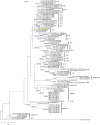Phylogenetic relationship of nonmammalian and avian Blastocystis isolates and conventional subtypes
- PMID: 36910318
- PMCID: PMC9998794
- DOI: 10.1007/s12639-022-01554-7
Phylogenetic relationship of nonmammalian and avian Blastocystis isolates and conventional subtypes
Abstract
Blastocystis is an intestinal protist commonly identified in human and animal feces. At present, there are 28 proposed subtypes (STs) identified based on the small subunit rRNA gene, 13 of which are found in both humans and animals. In general, nonmammalian and avian groups are infected by the nonmammalian and avian subtypes (NMASTs). However, NMASTs were also isolated from mammalian hosts, suggesting possible cross-contamination and transmission from nonmammalian and avian hosts to other animals and, potentially, humans. Thus, this study determined the possible relationship between NMAST sequences and conventional STs to provide new insights into Blastocystis classification, identification, and epidemiological significance. Phylogenetic trees were constructed using three statistical models, namely, Maximum Likelihood, Neighbor Joining, and Maximum Parsimony, based on the 30 NMAST sequences. The NMAST sequences formed groups clustered closely with other NMAST subtrees. Most sequences of nonmammalian and avian isolates formed distinct monophyletic clades based on their NMAST classification, with some clustering with mammalian and avian STs. These results indicate the close relationship between Blastocystis isolated from mammalian and avian hosts and nonmammalian and avian hosts.
Supplementary information: The online version contains supplementary material available at (10.1007/s12639-022-01554-7).
Keywords: Blastocystis; Nonmammalian and avian subtypes; Phylogeny; Subtypes.
© Indian Society for Parasitology 2022.
Conflict of interest statement
Conflicts of interestThe authors declare that they have no conflicts of interest.
Figures

Similar articles
-
Subtype-host patterns and genetic differentiation of Blastocystis sp. in the Philippines.Heliyon. 2024 Apr 3;10(7):e29019. doi: 10.1016/j.heliyon.2024.e29019. eCollection 2024 Apr 15. Heliyon. 2024. PMID: 38601700 Free PMC article.
-
Blastocystis phylogeny among various isolates from humans to insects.Parasitol Int. 2016 Dec;65(6 Pt B):750-759. doi: 10.1016/j.parint.2016.04.004. Epub 2016 Apr 16. Parasitol Int. 2016. PMID: 27091546 Review.
-
Prevalence and molecular subtyping of Blastocystis from dairy cattle in Kanagawa, Japan.Parasitol Int. 2018 Dec;67(6):702-705. doi: 10.1016/j.parint.2018.07.005. Epub 2018 Jul 18. Parasitol Int. 2018. PMID: 30009956
-
Molecular phylogeny of Blastocystis isolates from wild rodents captured in Indonesia and Japan.Parasitol Res. 2018 Sep;117(9):2841-2846. doi: 10.1007/s00436-018-5973-9. Epub 2018 Jul 2. Parasitol Res. 2018. PMID: 29968038
-
A summary of Blastocystis subtypes in North and South America.Parasit Vectors. 2019 Jul 29;12(1):376. doi: 10.1186/s13071-019-3641-2. Parasit Vectors. 2019. PMID: 31358042 Free PMC article. Review.
Cited by
-
Subtype-host patterns and genetic differentiation of Blastocystis sp. in the Philippines.Heliyon. 2024 Apr 3;10(7):e29019. doi: 10.1016/j.heliyon.2024.e29019. eCollection 2024 Apr 15. Heliyon. 2024. PMID: 38601700 Free PMC article.
References
-
- Cian A, El Safadi D, Osman M, Moriniere R, Gantois N, Benamrouz-Vanneste S, Delgado-Viscogliosi P, Guyot K, Li L-L, Monchy S, Noël C, Poirier P, Nourrisson C, Wawrzyniak I, Delbac F, Bosc S, Chabé M, Petit T, Certad G, Viscogliosi E. Molecular epidemiology of Blastocystis sp. in various animal groups from two french zoos and evaluation of potential zoonotic risk. PLoS ONE. 2017;12(1):e0169659. doi: 10.1371/journal.pone.0169659. - DOI - PMC - PubMed
-
- Gantois N, Lamot A, Seesao Y, Creusy C, Li L-L, Monchy S, Benamrouz-Vanneste S, Karpouzopoulos J, Bourgain J-L, Rault C, Demaret F, Baydoun M, Chabé M, Fréalle E, Aliouat-Denis C-M, Gay M, Certad G, Viscogliosi E. First report on the prevalence and subtype distribution of Blastocystis sp. in edible marine fish and marine mammals: a large scale-study conducted in Atlantic Northeast and on the coasts of Northern France. Microorganisms. 2020;8(3):460. doi: 10.3390/microorganisms8030460. - DOI - PMC - PubMed
LinkOut - more resources
Full Text Sources
